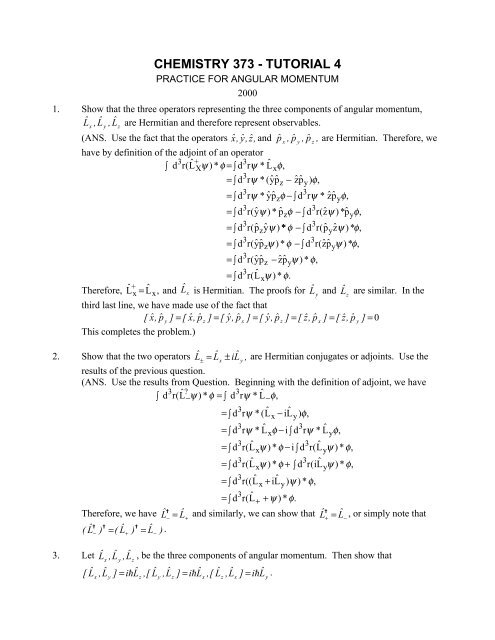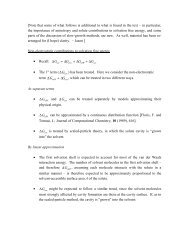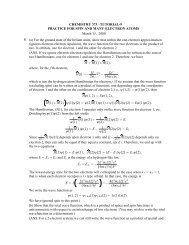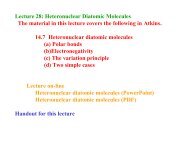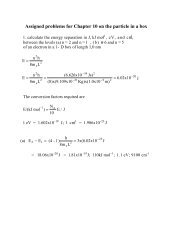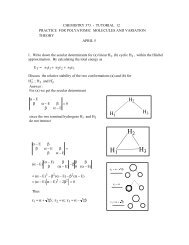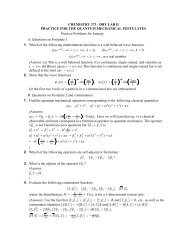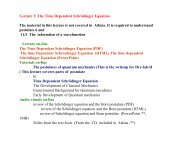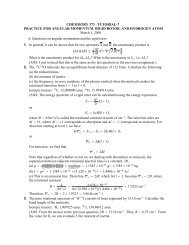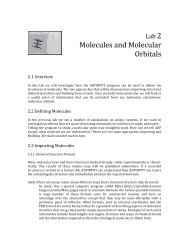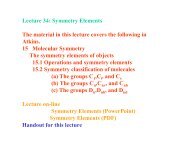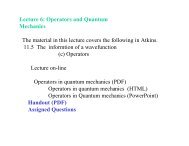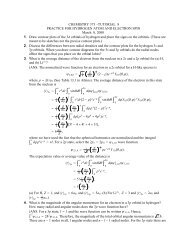Rigid Rotor and Angular Momentum - Cobalt
Rigid Rotor and Angular Momentum - Cobalt
Rigid Rotor and Angular Momentum - Cobalt
Create successful ePaper yourself
Turn your PDF publications into a flip-book with our unique Google optimized e-Paper software.
CHEMISTRY 373 - TUTORIAL 4PRACTICE FOR ANGULAR MOMENTUM20001. Show that the three operators representing the three components of angular momentum,Lˆ x,Lˆy, Lˆzare Hermitian <strong>and</strong> therefore represent observables.(ANS. Use the fact that the operators xˆ , ŷ, ẑ,<strong>and</strong> pˆx, pˆy, pˆz, are Hermitian. Therefore, wehave by definition of the adjoint of an operator3 3∫ drL ( ˆ +X ψ )* φ = ∫ dr ψ * L ˆ x φ ,3= ∫ drψ*(ˆ ypˆ z − zp ˆ ˆ y) φ,3 3= ∫ drψ * yp ˆ ˆ zφ− ∫ drψ * zp ˆ ˆ yφ,3 3= ∫ dry (ˆ ψ)*ˆ pzφ − ∫ drz (ˆ ψ)*ˆ pyφ,3= drpy (ˆ zˆ 3∫ ψ ) * φ − ∫ drpz (ˆ yˆ ψ)* φ,3(ˆ ˆ3= ∫ drypzψ)* φ − ∫ drzp (ˆ ˆ yψ)* φ,3= ∫ dryp (ˆ ˆ z − zp ˆ ˆ yψ)* φ,3= ∫ drL ( ˆ xψ)* φ.Therefore, ˆ +Lx= L ˆ x,<strong>and</strong> Lˆ x is Hermitian. The proofs for Lˆ y<strong>and</strong> Lˆ are similar. In thezthird last line, we have made use of the fact that[ xˆ , pˆy] = [ xˆ , pˆz] = [ ŷ, pˆx] = [ ŷ, pˆz] = [ ẑ, pˆx] = [ ẑ, pˆy] = 0This completes the problem.)2. Show that the two operators Lˆ = Lˆ ±± xiLˆy, are Hermitian conjugates or adjoints. Use theresults of the previous question.(ANS. Use the results from Question. Beginning with the definition of adjoint, we have3 3drL ( ˆ ?∫ − ψ )* φ = ∫ dr ψ * L ˆ − φ ,3= ∫ dr ψ *(ˆ Lx−iLˆ y) φ ,3 3= ∫ drψ * L ˆ xφ−idr ∫ ψ * L ˆ yφ,3 3= ∫ drL ( ˆ xψ)* φ−idrL∫ (ˆ yψ)* φ,3 3= ∫ drL ( ˆ xψ)* φ+ ∫ driL ( ˆ yψ)* φ,= ∫ dr 3 (( L ˆ x+iL ˆ y ) ψ )* φ ,= ∫ drL3 ( ˆ + + ψ )* φ .Therefore, we have Lˆ ✝ −= Lˆ <strong>and</strong> similarly, we can show that+Lˆ ✝+= Lˆ , or simply note that−✝ ✝✝Lˆ ) = ( Lˆ ) Lˆ ).(− +=−3. Let Lˆx,Lˆy, Lˆ , be the three components of angular momentum. Then show thatz[ Lˆ ,Lˆ ] = ih Lˆ ,[ Lˆ ,Lˆ ] = ihLˆ,[ Lˆ ,Lˆ ] = ihLˆ.xyzyzxzxy
2 2 2 2Also, if Lˆ = Lˆx+ Lˆy+ Lˆz, then show that222[ Lˆ ,Lˆx] = [ Lˆ ,Lˆy] = [ Lˆ ,Lˆz] = 0 .(ANS. Express Lˆ x,Lˆy, Lˆz, in terms of three components of position xˆ , ŷ, ẑ , <strong>and</strong> momentum,pˆx, pˆy, pˆz ,Lˆx= ŷpˆz− ẑpˆy,Lˆy= ẑpˆx− xˆpˆz,Lˆz= xˆpˆy− ŷpˆx.Making use of the commutators[ xˆ , pˆx] = [ ŷ, pˆy] = [ ẑ, pˆz] = ih ,<strong>and</strong>[ xˆ , pˆy] = [ xˆ , pˆz] = [ ŷ, pˆx] = [ ŷ, pˆz] = [ ẑ, pˆx] = [ ẑ, pˆy] = 0,[ pˆx, pˆy] = [ pˆx, pˆz] = [ pˆy, pˆz] = 0along with[ Â,Bˆ Ĉ ] = [ Â,Bˆ ]Ĉ + Bˆ [ Â,Ĉ ], [ ÂBˆ ,Ĉ ] = [ Â,Ĉ ]Bˆ + Â[ Bˆ ,Ĉ ]we see that[ Lˆx,Lˆy] = [ ŷpˆz− ẑpˆy,ẑpˆx− xˆpˆz],= [ ŷpˆz− ẑpˆx] + ẑpˆy,xˆpˆz],= ŷ[ pˆz,ẑ ] pˆx+ xˆ [ ẑ, pˆx] pˆy,= ih(xˆpˆy− ŷpˆx),= ihLˆz.In arriving at this result, I have made use of what I call "eyeballing" techniques. Themissing commutators such as [ ŷpˆz,xˆpˆz] <strong>and</strong> [ ẑpˆy,ẑpˆx] clearly vanish. Why? Similarly,we can show that[ Lˆy,Lˆz] = ih Lˆx, [ Lˆz,Lˆx] = ihLˆ.yWe can use these three commutators to solve the final one. Hence, we get222[ Lˆ ,Lˆx] = [ Lˆx,Lˆx] + [ Lˆy,Lˆx] + [ Lˆz,Lx],= [ Lˆy,Lˆx]Lˆy+ Lˆy[ Lˆy,Lˆx] + [ Lˆz,Lˆx]Lˆz+ Lˆz[ Lˆz,Lˆx],= − ihLˆzLy− ihLˆyLˆz+ ihLˆyLz+ ihLˆzLˆy,= 0.The proofs for the remaining two commutators are analogous. This completes the problem.)4. Prove the following commutation relations:[ Lˆz,Lˆ±] = ± hLˆ±, [ Lˆ+,Lˆ−] = 2hLˆz.(ANS. Begin with the first commutator <strong>and</strong> use the results of the previous question.
[ Lˆz,Lˆ−] = [ Lˆ= [ Lˆzz= ihLˆy= − h(Lˆ= − hLˆ,Lˆ,Lˆ− i( −ihLˆ−xxx.−iLˆ−i[ Lˆ−iLˆThe proof for [ Lˆz,Lˆ−] is analogous. Next we show the second commutator[ Lˆ ,Lˆ ] = [ Lˆ ,iLˆ ,Lˆ − iLˆ ],We are done.)5. Prove thatThen, show thatLˆLˆLˆ+−+ Lˆz= − 2i[ Lˆ= − 2i( ihLˆ= 2hLˆ.[ Lˆzzy,Lˆ2=+ − z z− +zy),yxy],],zx),,Lˆ),yy],− h ) = Lˆ Lˆ + Lˆ ( Lˆ + h ).22[±] =z]Lˆ,Lˆ(ANS. From the definitions of Lˆ <strong>and</strong>+Lˆ in the previous problem, we can write−1iLˆx= ( Lˆ−+ Lˆ+), Lˆy= ( Lˆ−− Lˆ+),222 2 2 2<strong>and</strong> substituting these expressions into Lˆ = Lˆ + Lˆ + Lˆ we obtain[ Lˆ2 12 12 2Lˆ = ( Lˆ−+ Lˆ+) − ( Lˆ−− Lˆ+) + Lˆz,441 22= ( Lˆ−+ Lˆ−Lˆ++ Lˆ+Lˆ−+ Lˆz),41 22 2− ( Lˆ−− Lˆ−Lˆ+− Lˆ+Lˆ−+ Lˆz) + Lˆz,412= ( Lˆ−Lˆ++ Lˆ+Lˆ−) + Lˆz).2Substituting the commutator [ Lˆ ,Lˆ ] = 2hLˆin either the form+ −zLˆ Lˆ = Lˆ Lˆ + 2hLˆor the+ − − + zform Lˆ Lˆ = Lˆ Lˆ − 2hLˆinto the above equation, yields the desired results− + + − z2Lˆ = Lˆ+Lˆ−+ Lˆz( Lˆz( Lˆz− h ) = Lˆ−Lˆ++ Lˆz( Lˆz+ h ).22The operator Lˆ commutes with Lˆ +, Lˆ , <strong>and</strong>− Lˆ commutes with all components of angularmomentum. See Question 3.)x,Lˆy= 0zzz
6. Prove that2 k2 kLˆ ( Lˆ ψ ) = j( j 1)h ( Lˆ ψ −− j , j+for any nonnegative integer k such that ( j − k ) h ⎣ S( Lˆz) . Also, let s be a nonnegativeinteger such that ( j−s) h ∈S(ˆ L z ) but ( j− ( s+ 1)) h ∈S( L ˆ z ). Then show thatˆ 2 ( ˆ s, ) ( )( ) 2L L j s j s (ˆ s−ψjj= − − −1h L−ψjj, ),Now, using Eq. (1) <strong>and</strong> (2), show that the only values for j are 0, 1/2, 1, 3/2, 2, … .2(ANS. To do this Question, we need the results from the previous Question. Since Lˆ commutes Lˆ −, it commutes with any power of Lˆ −. Therefore, we can writeˆ 2 ( ˆ k) ˆ k( ˆ 2L L−ψjj, = L−L ψjj, ),ˆ k= L−( L ˆ − L ˆ + ψjj , + L ˆ z + h) ψjj, ),2 k= jj ( + 1) h (ˆ L−ψjj , ).2For the second equality, we choose the other expression for Lˆ . In addition, we shall needS + 1sss ssthe results (from class) that Lˆ −ψj , j= 0 , <strong>and</strong> [ Lˆz,Lˆ−] = − shLˆ−or LˆzLˆ−= Lˆ−Lˆz− khLˆ,−where s is a nonnegative interger. Therefore we can write2 sS + 1sLˆ ( L ψ ) = Lˆ Lˆ ψ + Lˆ ( Lˆ − h )( Lˆ ψ )−j , j= Lˆ= Lˆzz+−( Lˆ( Lˆs−Lˆs= ( j − s ) hLˆ( Lˆ ψ= ( j − s ) h(Lˆzzj , j( Lˆ ψs−− shLˆs−Lˆ)) − hLˆ) ψ− shLˆ= ( j − s )( j − s −1)hzj , jzzs−j , jzj , j= ( j − s ) h(j − s ) h(Lˆ ψ−− h(Lˆ) ψj , jLˆ) −(j − s ) hs−z).),s( Lˆ ( Lˆ ψs−j , j( Lˆ ψ2s−zj , j),− shLˆ−(j − s ) h) −(j − s ) hj , j−s−−j , jzj , j( Lˆ ψIn the first equality, set k = s, <strong>and</strong> then we have2 k2 sj(j + 1)h ( Lˆ ψ ) = ( j − s )( j − s −1)h ( Lˆ ψ −−j , j2s−s−j , j) ψ),s−j , js−( Lˆ ψ2,( Lˆ ψwhich means thatj(j + 1)= ( j − s )( j − s −1).This equation yields the quadratic equation in s2s −(2 j −1)s− 2 j = 0,which has two solutions s = 2j <strong>and</strong> s = -1. Since s must be a nonnegative integer, the secondroot is extraneous. Since s must be a nonnegative integer, then 2j must be a nonnegativeinteger. Therefore, j = 0, 1/2, 1, 3/2, 2, …)7. (Optional) Prove thatψ1⎡ 1 ( j+m)!⎤21jm , = ⎢( j)!( j−m)!⎥ j−m⎣ 2 ⎦ h− −jj ,(ANS. We start from the result given in classLˆψj mLˆ ψ .2= [( j + m )( j − m )] hψ− j ,m+1j ,m−11.2j , j),j , jj , j),),
If m = j, then we getOperating with Lˆ −again, we find thatLˆ2−ψj , j2Lˆ−ψ, j= [( 2 j )( 1)]hψj , j−j 1= [( 2 j )( 1)]Repeating this k times, we observe that12hLˆψ= [( 2 j )( 2 j −1)(2〈1)]−1j , j−1,12.hLˆψ−j , j−2ˆ kkL ψ = [( 2j)( 2j−1)...( 2j− k+ 1)( k• ... 2•1) 2 h ψ ,−jj , jj , −k1⎡ ( 2j)!( )! ! ,j k k ⎤2k= ⎢jj−k⎣ −⎥ h ψ2 ⎦.Inverting the formula, we haveψ1( j k)!jj , − k = 1 ⎡ 1 2 − ⎤2k ⎢jj ,⎣( 2j)!k!⎥h⎦Now, let k = j - m. Then, the result follows.)1kLˆ h ψ .8. Given the normalized spherical harmonic for l = 2 <strong>and</strong> m = 2,115 2 2 2Y22e i ϕ, ( θϕ , ) = ⎛ ⎞sin θ ,⎝ 32π⎠derive the other four spherical harmonics for l = 2 using the equation in the previousquestion. What is the difference between j <strong>and</strong> l?(ANS. It is easier to apply the operator Lˆ , expressed in spherical polar coordinates,−repeatedly to obtain the desired functions. So, sinceˆ −iϕ⎛ ∂L−=− e i cot∂ − ∂ ⎞h ⎜ θ ⎟⎝ θ ∂ ϕ ⎠we haveˆ −i⎛ ∂iL−Y , ( , ) =− e icot sin e ,∂ − ∂ ⎞⎜⎟ ⎛ 1ϕ15 ⎞ 2 2 2 ϕ22 θϕ hθ θ⎝ θ ∂ ϕ ⎠ ⎝ 32 π ⎠1−ii=− ⎛ 15 ⎞ 2 ϕ⎛∂e icot sin e ,⎝ ⎠ ∂ − ∂ ⎞ 2 2 ϕh ⎜ θ ⎟ θ32π⎝ θ ∂ ϕ ⎠1−ii=− ⎛ 15 ⎞ 2 ϕ 2 ϕ2 2iϕhe( 2sinθe − icotθsin θ( 2i) e ),⎝ 32π⎠1=− ⎛ 15 ⎞ 2iϕh4sinθcosθe⎝ 32π⎠= 2hY21, ( θφ , ).Therefore, solving for Y2 , 1(θ , φ ) , we obtain.
115 2Y21, ( θφ , ) =− ⎛ ⎞sinθcosθe iκ⎝ 8π⎠Following the same process, we getˆ −i⎛ ∂iL−Y , ( , ) =− e icot sin cos e ,∂ − ∂ ⎞⎛⎜⎟ − ⎛ 1⎞ϕ15⎞ 2 2 ϕ21 θϕ hθ θ⎝ θ ∂ ϕ ⎠⎜⎝ 32 π ⎠⎟⎝⎠1−iϕ i i=− e⎛ 15 ⎞ 2 2 2 ϕ ϕh ((cos θ−sin θ) e −icotθsinθcos θ( i) e ),⎝ 8π⎠1= ⎛ 15 ⎞ 2 2 2h ( 2cos θ− 1+cos θ),⎝ 8π⎠115 2 2= h⎛ ⎞( 3cos θ −1),⎝ 8π⎠= 6hY20, ( θϕ , ).Solving for Y2 , 0(θ , ϕ ) , we have15 2 2Y 20 , ( θφ , ) = ⎛ ⎞( 3cos θ −1).⎝16π⎠For Y2 , 1(θ , ϕ ) , we proceedˆ −i⎛ ∂L−Y , ( , ) =− e icot ( cos )∂ − ∂ ⎞⎜⎟ ⎛ 1ϕ5 ⎞ 2 220 θϕ hθ 3 θ −1⎝ θ ∂ ϕ ⎠⎝16π ⎠1i=− ⎛ 5 ⎞ 2 ϕh e ( −6sinθcos θ),⎝16π⎠1−i= ⎛ 5 ⎞ 2ϕh 6sinθcos θe,⎝16π⎠= 6hY2,−1( θϕ , ).Solving for Y2 , 1(θ , ϕ ) , we have15 2Y21, ( θφ , ) sin cos e i ψ= ⎛ ⎞−θ θ⎝ 8π⎠Finally, for Y2 , − 2(θ , ϕ ) , we find that
Hence,ˆ −iϕ⎛∂−iL−Y , ( , ) =− e icot sin cos e ,∂ − ∂ ⎞⎜⎟ ⎛ 5 ⎞ 2ϕ21 θϕ hθ θ θ⎝ θ ∂ ϕ ⎠⎝8 π ⎠=− ⎛ 5h⎞⎝ 8π⎠112 2 2iϕ −iϕ −iϕe ((cos θ −sin θ) e icotθsinθcos θ( −i) e ),= ⎛ 15 ⎞ 2 2−iϕh (cos θ−sinθ−cosθ) e ,⎝ 8π⎠= ⎛ 15h⎞⎝ 8π⎠= 2hY2,−212 2 2− iϕsin θ e ,( θϕ , ).15 2 2 −2iY2, −2( , ) = ⎛ ⎞ϕθϕ sin θ e⎝ 32π⎠This process is somewhat laborious but h<strong>and</strong>y if tables of functions are unavailable.)9. In general, it can be shown that for two operators Â<strong>and</strong> Bˆ , the uncertainty product is1 3( ∆A)( ∆B) ≥ ∫ d rΨ*[ A,ˆ B] Ψ .2What is the uncertainty product for ∆ L ∆L? What is the uncertainty in Lz ?xy(ANS. Suppose that we choose Ψ to be an eigenstate of L ,Y ( θ , ϕ ). Then, we see that1 3 *∆Lx∆Ly≥∫ d rYjm , ( θϕ , )[ˆ Lx, L ˆ y] Yjm, ( θϕ , ),21 3 *≥ ∫ drYjm , ( θϕ , ) iLY h ˆx jm , ( θϕ , ),21 2≥ i m =m 2hh2 2We also have ∆Lz= 0.)11zj , m


